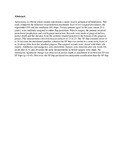| dc.contributor.author | Chindia, ML | |
| dc.contributor.author | Valderhaug, J | |
| dc.date.accessioned | 2013-06-25T06:16:26Z | |
| dc.date.available | 2013-06-25T06:16:26Z | |
| dc.date.issued | 1995-09 | |
| dc.identifier.citation | East Afr Med J. 1995 Sep;72(9):564-7. | en |
| dc.identifier.uri | http://www.ncbi.nlm.nih.gov/pubmed/7498042 | |
| dc.identifier.uri | http://erepository.uonbi.ac.ke:8080/xmlui/handle/123456789/39341 | |
| dc.description.abstract | Apicectomy is offered where routine endodontics cannot resolve periapical inflammation. This study compared the influence on periodontal attachment level of two surgical procedures, the trapezoidal (TF) and the semilunar (SF) flaps. Twenty patients aged 16-44 years (mean 23.2 years), were randomly assigned to either flap procedure. Prior to surgery the patients received periodontal prophylaxis and oral hygiene instruction. Records were made of gingival indices, pocket depth and the distance from the cemento-enamel junction to the bottom of the gingival pocket. The measurements involved buccal surfaces of 13 to 23. The TF flap extended from 14 to 24 between the interdental papillae, whereas the SF flap was carried in a semi circle from 14 to 24 about 2mm from the attached gingiva. The surgical wounds were closed with black silk sutures. Antibiotics and analgesics were prescribed. Sutures were removed after one week. On recall after 6, 12 and 24 weeks the same measurements as before surgery were made. No statistically significant change was observed in pocket depth or attachment level between TF and SF flaps (p > 0.05). However, the TF flap produced less noticeable scarification than the SF flap. | en |
| dc.language.iso | en | en |
| dc.publisher | University of Nairobi | en |
| dc.title | Periodontal status following trapezoidal and semilunar flaps in apicectomy | en |
| dc.type | Article | en |
| local.publisher | Department of Dental Surgery, College of Health Sciences, University of Nairobi. | en |

